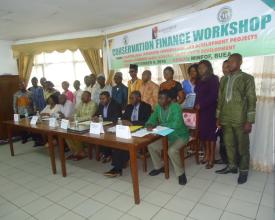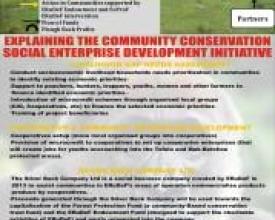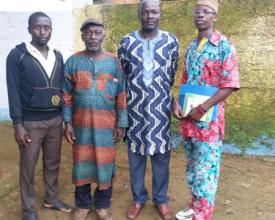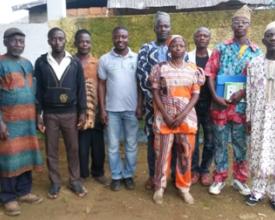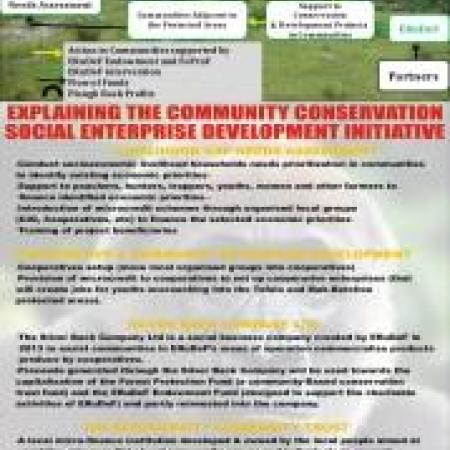
La Iniciativa de Desarrollo de Empresas Sociales para la Conservación de la Comunidad (CoCoSED)
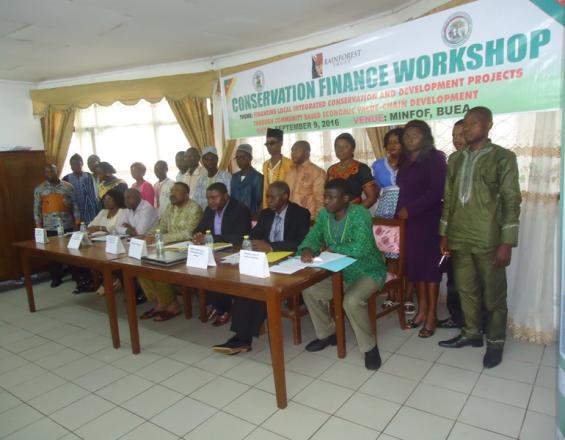
La Iniciativa de Desarrollo de Empresas Sociales para la Conservación Comunitaria (CoCoSED, por sus siglas en inglés) es una iniciativa que busca proporcionar financiación sostenible a las actividades de conservación, al tiempo que proporciona resiliencia económica y financiera a largo plazo a las comunidades adyacentes a las áreas protegidas, los puntos calientes de biodiversidad y los paisajes frágiles.
Antes de la puesta en marcha de esta Iniciativa en 2016, los gorilas registrados eran entre 25 y 35 individuos, pero ahora hay unos 45 gorilas y entre 180 y 200 chimpancés. Además, más de 1000 miembros de las comunidades adyacentes al área protegida han recibido formación sobre la conservación de la biodiversidad y se les han proporcionado fuentes alternativas de sustento para aumentar los ingresos de las comunidades, así como para la conservación de la biodiversidad.
Contexto
Défis à relever
La zona de las tierras altas de Lebialem, donde se encuentra esta área protegida, es una de las más pobres de Camerún. Niveles de ingresos muy bajos (normalmente menos de ½ dólar al día), escasas aptitudes para la gestión de la tierra, falta de facilidades de crédito, falta de acceso a los mercados y falta de atención médica caracterizan a todas las comunidades de las tierras altas, especialmente a las que lindan con el área protegida y a las que carecen por completo de vías de acceso. Su economía se basa esencialmente en la caza, la agricultura, la recolección y la pesca. Su potencial agrícola es escaso, sobre todo porque siguen cultivando en tierras marginales que cada año sufren corrimientos de tierra, y sus opciones económicas son escasas debido a la falta de acceso a los mercados. Dependen exclusivamente del bosque para su subsistencia.
Así pues, esta Iniciativa pretende hacer frente a estos retos proporcionando a la población local fuentes de ingresos sostenibles alternativas para desviar su atención del bosque y conservar también la biodiversidad. Y mejorar aún más sus medios de subsistencia.
Ubicación
Procesar
Resumen del proceso
Los bloques están interrelacionados de la siguiente manera: agrupar los distintos hogares en cooperativas junto con el desarrollo de empresas cooperativas. El objetivo de agrupar a los hogares en cooperativas es garantizar que todos los productos domésticos se compren y comercialicen a través del trabajo de la cooperativa. Además, la cooperativa ahorrará a través del Biodiversity Community Trust y también se concederán microcréditos a la cooperativa para llevar a cabo actividades de inversión. En esta fase, todos los beneficios (100%) volverán a la cooperativa para su reinversión. Para garantizar la continuidad de la cooperativa, ERuDeF a través de su División de Negocios Sociales (Silver Back Company Limited) comprará entonces todos los productos de la cooperativa a un precio superior al que ellos compran los productos para que la cooperativa pueda obtener algún beneficio.
Además, con el fin de obtener financiación sostenible para llevar a cabo un desarrollo sostenible y garantizar la conservación de la biodiversidad, los beneficios de la microfinanciación local (30%) y del negocio social (60%) se envían al Fondo de Protección Forestal. En esta fase, el dinero se utiliza para llevar a cabo iniciativas comunitarias de conservación, como la aplicación de la ley, la lucha contra la caza furtiva, la vigilancia forestal y proyectos de ecodesarrollo.
Bloques de construcción
Desarrollo de cooperativas y empresas cooperativas
El objetivo de agrupar a los hogares en cooperativas es garantizar que todos los productos de los hogares se compran y comercializan a través de la cooperativa. De este modo, los miembros de la cooperativa podrán vender sus productos a un precio más elevado. Además, la cooperativa ahorrará a través del Biodiversity Community Trust (BCT) y también se concederán microcréditos a la cooperativa para llevar a cabo actividades de inversión. En esta fase, todos los beneficios (100%) volverán a la cooperativa para su reinversión. Para garantizar la continuidad de la cooperativa, la Fundación para el Medio Ambiente y el Desarrollo Rural (ERuDeF), a través de su División de Empresas Sociales (Silver Back Company Limited), comprará todos los productos de la cooperativa a un precio superior al precio de coste para que la cooperativa pueda obtener algún beneficio.
Factores facilitadores
Existe colaboración entre los miembros de la comunidad y la Fundación para el Medio Ambiente y el Desarrollo Rural.
Los miembros de la comunidad comprenden la importancia de la sociedad cooperativa para el desarrollo económico local.
Capacitación de los miembros de la comunidad en la gestión de cooperativas y empresas cooperativas.
Compromiso de los miembros de la comunidad con la protección de su entorno.
Lección aprendida
Las lecciones aprendidas incluyen: necesidad de más fondos para intensificar la aplicación, falta de colaboración por parte de algunos miembros de la comunidad,
Institución local de microfinanciación
Es una institución local de microfinanciación desarrollada y propiedad de la población cuyo objetivo es conceder microcréditos a grupos e individuos locales para apoyar proyectos ecológicos.
Remite el 30% de sus beneficios y excedentes anuales al Fondo de Protección Forestal para apoyar proyectos de conservación y caridad.
Factores facilitadores
Las condiciones son: formación y capacitación constantes sobre la importancia de las instituciones microfinancieras para el desarrollo económico, seguimiento constante para garantizar su aplicación efectiva, contratación de personal formado en el ámbito de la gestión y el desarrollo de las microfinanzas.
Lección aprendida
Los retos a los que se enfrenta la aplicación de este elemento son;
Fondos insuficientes para intensificar la educación de los miembros; algunas comunidades adyacentes a la zona protegida se resisten a la innovación.
Empresa social para la comercialización de productos cooperativos
Silver Back Company Ltd es una empresa social creada por la Fundación para el Medio Ambiente y el Desarrollo Rural (ERuDeF) en 2013 para ayudar a las comunidades de las zonas de operación de ERuDeF a comercializar los productos producidos por las cooperativas.
Los ingresos generados a través de Silver Back Company se utilizarán para capitalizar el Fondo de Protección Forestal (un fondo fiduciario de conservación comunitario) y el Fondo de Dotación de ERuDeF (destinado a apoyar las actividades benéficas de ERuDeF) y se reinvertirán parcialmente en la empresa.
Factores facilitadores
Entre los factores se incluyen: la disponibilidad de productos forestales no madereros como el aceite de palma, el eru, la miel natural y los subproductos, etc., la disponibilidad de sociedades cooperativas bien organizadas en la zona protegida y la colaboración de las comunidades locales.
Lección aprendida
Las lecciones aprendidas incluyen;
Es necesario establecer una nueva estrategia para mejorar la aplicación efectiva.
Hay que intensificar la formación y el desarrollo de capacidades.
Identificar nuevos productos y desarrollar sus correspondientes cadenas de valor.
Hay que formar a las cooperativas y desarrollar sus capacidades en materia de producción sostenible de bienes.
El Fondo de Protección de los Bosques
El Fondo de Protección Forestal (FoProF) es un fondo fiduciario comunitario de conservación creado para apoyar las iniciativas de conservación de los comités de conservación de las aldeas, como la aplicación de la ley, la vigilancia forestal y los proyectos de ecodesarrollo (agua potable, educación, etc.). Sus fondos proceden esencialmente de Biodiversity Community Trust (institución local de microfinanciación creada por ERuDeF), donaciones y beneficios de Silver Back Company (empresa social para la comercialización de productos cooperativos).
Factores facilitadores
- Creación de un comité de gestión
- Colaboración de los miembros de la comunidad
- Preparación y voluntad de los guardabosques locales para participar en la vigilancia forestal
Lección aprendida
- La colaboración constante con los miembros del comité da más resultados
- Es necesario impartir más formación y desarrollar las capacidades del comité de gestión en el ejercicio de sus funciones.
Impactos
Gracias a esta iniciativa, ha aumentado el número de especies amenazadas, como los chimpancés (entre 180 y 200), los gorilas del río Cross (de 25 a 35 en 2016 a unos 45 individuos) y algunas especies vegetales clave. Además, se ha capacitado a más de 1000 habitantes en la gestión de áreas protegidas y en la importancia de conservar el medio ambiente.
Desde el punto de vista social, se han formado asociaciones de mujeres y se han desarrollado sus capacidades en actividades alternativas generadoras de ingresos. Se han donado libros a las personas más vulnerables para facilitar su educación. Se ha apoyado el desarrollo de infraestructuras escolares en esta zona protegida.
Desde el punto de vista económico, se ha contratado a más de setenta jóvenes en diversas unidades. Los ingresos de las familias han aumentado (de menos de un dólar al día a 1 dólar al día), se han creado cuatro industrias artesanales y se ha facilitado a las comunidades el acceso a los mercados para comercializar sus productos.
Beneficiarios
Los principales beneficiarios de esta innovación son la población más vulnerable que vive junto a la zona protegida. Entre ellos se encuentran: cazadores, tramperos, agricultores, hogares con pocos recursos, mujeres y jóvenes.
Objetivos de Desarrollo Sostenible
Historia

Para apoyar los proyectos de conservación y desarrollo en las comunidades adyacentes a las zonas protegidas, ERuDeF, a través de sus socios, empieza por realizar una evaluación de las necesidades en materia de medios de subsistencia. Se trata de conocer la situación socioeconómica de las personas que viven junto a las zonas protegidas.
Una vez conocida esta situación, el siguiente paso es el desarrollo de los medios de subsistencia de los hogares. En esta fase, los hogares reciben formación sobre actividades alternativas generadoras de ingresos, como la apicultura, la cría de cerdos, etc. Todo ello para mejorar sus condiciones de vida. Además, las familias recibirán microcréditos a través del Biodiversity Community Trust (BCT) para mejorar sus inversiones y, al mismo tiempo, ahorrarán para futuras inversiones en el BCT. Por otra parte, los beneficios obtenidos a nivel de hogar volverán a ellos a través de las ventas de sus productos. Además, los hogares recibirán donaciones de ERuDeF, como lechones, y al cabo de un año tendrán que devolver el lechón donado en forma de regalo, que se entregará al siguiente hogar, y así sucesivamente.
Una vez completado el desarrollo de los hogares, el siguiente paso consiste en agruparlos en cooperativas, junto con el desarrollo de empresas cooperativas. El objetivo de agrupar los hogares en cooperativas es garantizar que todos los productos de los hogares se compren y comercialicen a través del trabajo de la cooperativa. Además, la cooperativa ahorrará a través de la BCT y también se concederán microcréditos a la cooperativa para llevar a cabo actividades de inversión. En esta fase, todos los beneficios (100%) volverán a la cooperativa para su reinversión. Para garantizar la continuidad de la cooperativa, ERuDeF, a través de su División de Empresa Social, comprará entonces todos los productos de la cooperativa a un precio superior al que compran los productos para que la cooperativa pueda obtener algún beneficio.
A continuación, Silver Back Company Ltd buscará mercado para vender los productos que ha comprado a las cooperativas. En esta fase, el 40% de su beneficio se reinvertirá en la empresa, mientras que el 60% se destinará al Fondo de Dotación de ERuDeF. A este nivel, el 30% del Fondo se destinará a la gestión del área protegida, mientras que el 30% restante irá al Fondo de Protección Forestal (FoProF).
A nivel de la BCT, el 30% de su beneficio anual también se destinará al FoProF.
